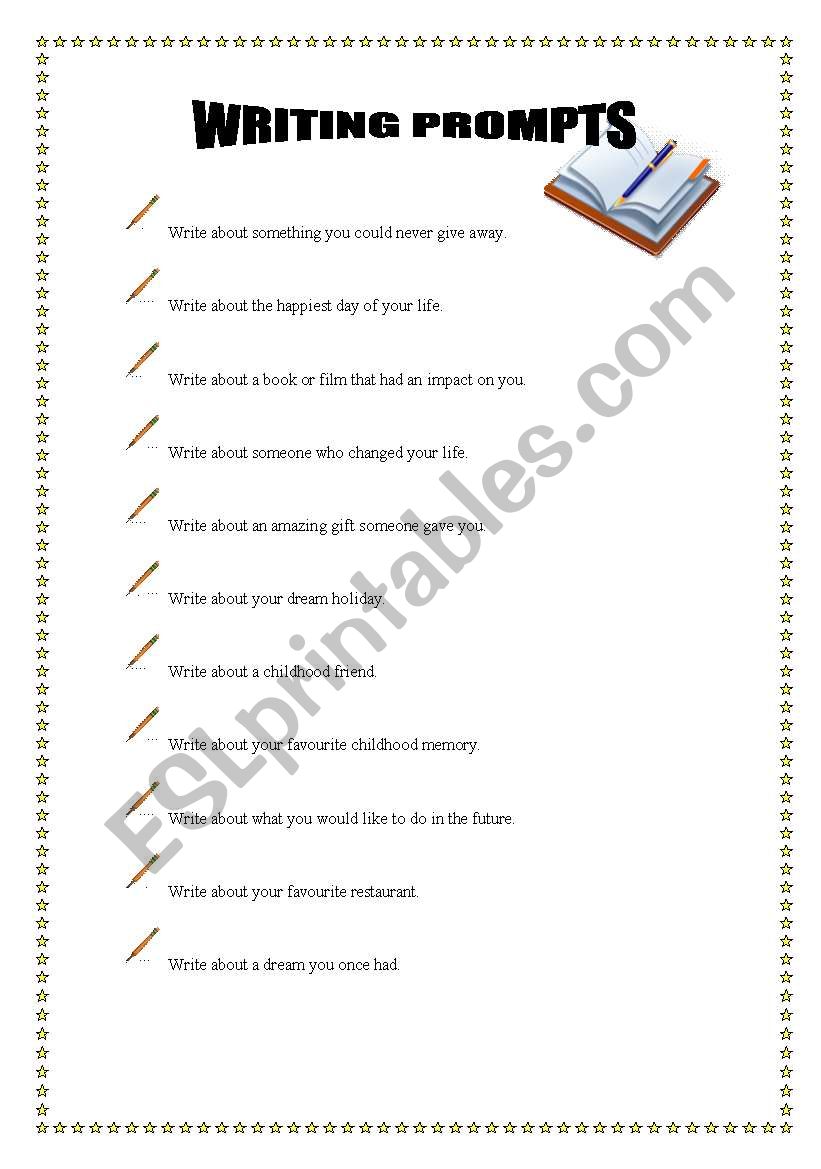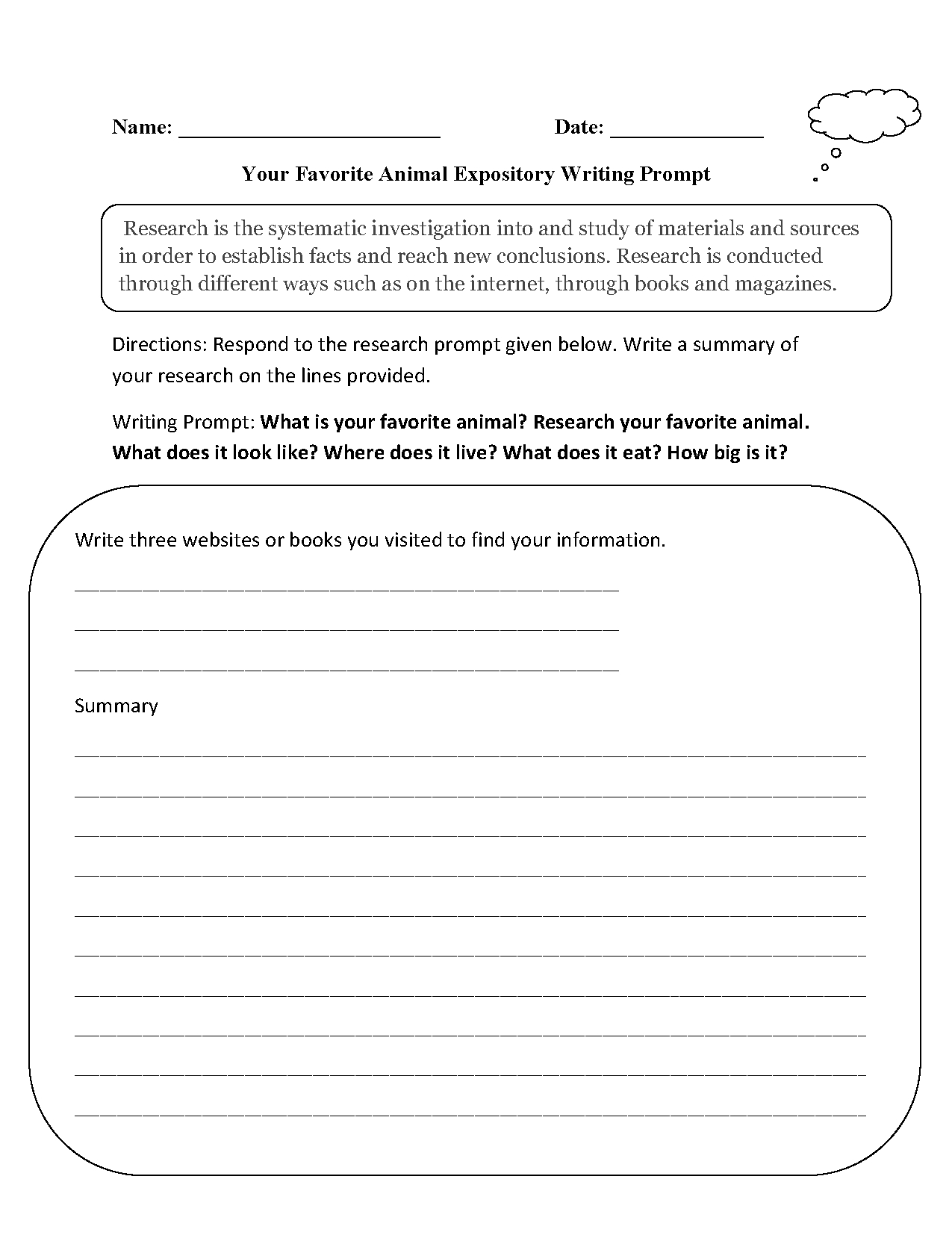
Beyond the Blank Page: Crafting Engaging Writing Prompts for ESL Worksheets
The journey of mastering a new language is multifaceted, encompassing listening, speaking, reading, and writing. For English as a Second Language (ESL) learners, writing often presents the most significant hurdle. It demands not only grammatical accuracy and vocabulary recall but also the ability to organize thoughts, express ideas coherently, and adapt to cultural nuances in communication. This is where the art of crafting effective writing prompts for ESL worksheets becomes indispensable. Far from being mere assignments, well-designed prompts are powerful tools that can unlock creativity, build confidence, and solidify linguistic competence.
This article delves into the critical role of well-designed writing prompts for ESL worksheets, exploring their characteristics, diverse types, and strategic approaches to their creation. We will uncover how these seemingly simple questions can transform a daunting blank page into an exciting canvas for language exploration and personal expression.
Why Are Effective Writing Prompts Crucial for ESL Learners?

For many ESL students, the act of writing can trigger anxiety. They might struggle with generating ideas, finding the right words, or structuring their thoughts in a foreign language. Effective writing prompts serve several vital functions:

- Overcoming Writer’s Block: A blank page can be intimidating. Prompts provide a starting point, a clear direction, and often a pre-defined context, reducing the initial paralysis many learners face.
- Scaffolding Language Acquisition: Prompts can be designed to target specific grammar points, vocabulary sets, or discourse structures (e.g., comparing and contrasting, narrating an event). This focused practice reinforces learning from other areas of the curriculum.
- Encouraging Critical Thinking and Creativity: Beyond rote memorization, good prompts encourage learners to think critically, analyze situations, form opinions, and express them imaginatively. They move students from merely reproducing language to producing original thought.
- Providing a Safe Space for Error and Improvement: Writing allows students to take their time, draft, and revise. Prompts facilitate this process by providing a clear framework within which they can experiment with language without the pressure of real-time spoken interaction. Errors become learning opportunities, not public embarrassments.
- Connecting to Real-World Communication: The ultimate goal of language learning is communication. Prompts can simulate real-life writing scenarios, such as writing an email, a review, a letter of complaint, or a short news report, preparing students for practical application of their skills.



Characteristics of a Great Writing Prompt

Not all prompts are created equal. An effective prompt possesses several key characteristics that maximize its pedagogical impact:
- Clarity and Simplicity: The prompt should be easy to understand, even for learners with limited proficiency. Avoid complex sentence structures or obscure vocabulary within the prompt itself.
- Relevance and Interest: Prompts should resonate with the learners’ lives, experiences, and interests. Topics that are culturally appropriate and relatable will naturally generate more engagement and ideas.
- Open-endedness (with Guidance): While providing a clear topic, a good prompt allows for diverse responses and interpretations. It should not have a single "right" answer. However, for lower levels, some guidance (e.g., sentence starters, a word bank) can be beneficial.
- Appropriate Language Level: The expected output should align with the students’ current proficiency level. A prompt that is too difficult will lead to frustration, while one that is too easy might not challenge them sufficiently.
- Purpose-Driven: Every prompt should have a clear learning objective. Is it to practice past tense verbs? To express opinions? To describe a sequence of events? This objective should guide its design.
- Cultural Sensitivity: Ensure prompts are inclusive and respectful of all cultural backgrounds in the classroom. Avoid topics that might be controversial or unfamiliar to certain students.



Types of Writing Prompts for ESL Worksheets
The diversity of writing prompts for ESL worksheets is vast, each type serving a different purpose and targeting specific skills. Teachers should employ a variety of these to keep lessons fresh and cater to different learning styles and proficiency levels.
-
Personal Reflection/Opinion Prompts:
- Purpose: Encourage self-expression, build confidence, and practice expressing opinions, feelings, and personal experiences.
- Examples:
- "What is your favorite holiday, and why? Describe how you celebrate it." (A1/A2)
- "Do you prefer living in a big city or a small town? Explain your reasons, giving examples." (B1)
- "Reflect on a time you faced a challenge and how you overcame it. What did you learn?" (B2/C1)
-
Narrative/Storytelling Prompts:
- Purpose: Develop sequencing, descriptive language, past tense usage, and creative imagination.
- Examples:
- "Look at these three pictures. Write a short story that includes all three items." (A1/A2)
- "Continue this story: ‘One rainy Tuesday morning, I woke up to a strange noise coming from my kitchen…’" (B1)
- "Write a short story from the perspective of an animal living in a big city." (B2/C1)
-
Descriptive Prompts:
- Purpose: Enhance vocabulary related to senses (sight, sound, smell, touch, taste), adjectives, and adverbs.
- Examples:
- "Describe your favorite food. What does it look, smell, and taste like?" (A1/A2)
- "Imagine you are in your dream vacation spot. Describe what you see, hear, and feel there." (B1)
- "Describe a piece of art that deeply moved you. Use vivid language to convey its appearance and your emotional response." (B2/C1)
-
Expository/Informative Prompts:
- Purpose: Practice explaining processes, comparing and contrasting, summarizing information, and using logical connectors.
- Examples:
- "Explain how to make your favorite simple dish." (A2/B1)
- "Compare and contrast two different types of transportation (e.g., car vs. bicycle) in terms of benefits and drawbacks." (B1/B2)
- "Summarize a recent news article you read about environmental issues, stating the main problem and proposed solutions." (B2/C1)
-
Persuasive/Argumentative Prompts:
- Purpose: Develop argumentation skills, presenting evidence, counter-arguments, and using persuasive language.
- Examples:
- "Convince your friend to try your favorite sport or hobby." (B1)
- "Argue for or against the use of smartphones in the classroom." (B2)
- "Should social media companies be responsible for the content posted by their users? Present your argument with supporting points." (C1)
-
Creative/Imaginative Prompts:
- Purpose: Foster imaginative thinking, fluency, and the ability to play with language beyond strict grammatical rules.
- Examples:
- "If you could have any superpower, what would it be and how would you use it?" (A2/B1)
- "Imagine you wake up one day and can understand animals. What is the first conversation you have?" (B1/B2)
- "Write a short dialogue between a historical figure and a modern-day celebrity." (B2/C1)
-
Picture-Based/Visual Prompts:
- Purpose: Stimulate ideas, encourage descriptive writing, and help visual learners. Can be used across all levels.
- Examples:
- "Look at this picture. Describe what you see." (A1)
- "Write a story about what happened before and after this photo was taken." (A2/B1)
- "Analyze this advertisement. What message is it trying to send? Who is its target audience?" (B1/B2)
-
Role-Play/Situational Prompts:
- Purpose: Practice functional language in specific contexts, preparing for real-world interactions.
- Examples:
- "You ordered food at a restaurant, but it’s not what you wanted. Write a short complaint to the waiter/waitress." (A2/B1)
- "Write an email to a potential employer explaining why you are the best candidate for the job." (B1/B2)
- "You are a local council member. Write a speech to convince your community to support a new park project." (B2/C1)
Strategies for Crafting Engaging Writing Prompts
Crafting engaging writing prompts for ESL worksheets is an art that combines pedagogical insight with creativity. Here are some strategies to enhance their effectiveness:
- Know Your Learners: Understand their age, cultural backgrounds, interests, and current proficiency levels. A prompt suitable for a teenage class might not work for adult professionals.
- Provide Scaffolding: Especially for lower-level learners, scaffolding is crucial. This can include:
- Word Banks: A list of relevant vocabulary words.
- Sentence Starters: Phrases like "I think that…", "First, you need to…", "In my opinion…".
- Graphic Organizers: Mind maps, Venn diagrams, or flowcharts to help students organize their thoughts before writing.
- Model Texts: A short example of the expected writing style or structure.
- Vary Prompt Types: Don’t stick to just one type of prompt. Rotating between personal, narrative, descriptive, and argumentative prompts keeps students engaged and develops a wider range of writing skills.
- Connect to Other Skills: Integrate writing prompts with reading texts, listening activities, or classroom discussions. For instance, after reading an article, students could write a response, summary, or opinion piece.
- Incorporate Authentic Materials: Use real-world materials like news headlines, advertisements, song lyrics, or short video clips as inspiration for prompts. This makes the learning more relevant and engaging.
- Encourage Peer Feedback and Collaboration: Allow students to share their drafts with classmates for feedback. This not only improves their writing but also develops their critical thinking and communication skills. Prompts can even be designed for collaborative writing.
- Offer Choice: Whenever possible, give students a choice of two or three prompts. This empowers them, reduces pressure, and allows them to write about something they are genuinely interested in.
- Pre-writing Activities: Before diving into writing, dedicate time to pre-writing activities. Brainstorming, outlining, free writing, or quick discussions can help students generate ideas and structure their thoughts.
- Clear Rubrics/Expectations: Provide a clear rubric or list of expectations for the writing task. Students need to know what aspects of their writing will be assessed (e.g., grammar, vocabulary, organization, content).
Common Pitfalls to Avoid
Even with good intentions, some prompt designs can hinder learning:
- Too Vague: "Write about your life" is too broad and overwhelming.
- Too Specific/Restrictive: "Write a five-sentence paragraph about a red apple using only words starting with ‘a’" stifles creativity.
- Uninteresting Topics: Prompts that don’t resonate with student interests or are culturally irrelevant will lead to disengagement.
- Lack of Purpose: If students don’t understand why they are writing, they are less likely to put effort into it.
- Culturally Inappropriate: Topics that might be sensitive or misunderstood in certain cultures should be avoided.
- Assuming Prior Knowledge: Don’t assume students have background knowledge on every topic. Provide context if necessary.
Conclusion
The blank page can be a daunting adversary for any writer, especially for those navigating the complexities of a new language. However, with thoughtful design and strategic implementation, writing prompts for ESL worksheets transform this challenge into an opportunity for growth and expression. They are not merely assignments but catalysts that spark imagination, build linguistic confidence, and pave the way for effective communication.
By understanding the crucial role of prompts, embracing their diverse types, and applying sound pedagogical strategies, educators can empower ESL learners to move beyond hesitation and discover the joy and power of writing in English. The deliberate and thoughtful creation of writing prompts for ESL worksheets is an investment in our students’ linguistic journey, equipping them with the essential skills to articulate their thoughts, feelings, and ideas in a new linguistic landscape.
